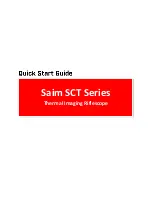
4
3. Assembly
Assembly should take no more than 30 minutes. Refer to
Figure 1 during assembly. Assembling the telescope requires
no tools other than the ones provided.
1. Stand the tripod legs upright and spread the legs out as far
as they will go. Make certain that the leg lock levers are
tightened. Keep the tripod legs at their shortest (fully
retracted) length, for now.
2. Place the base of the equatorial mount onto the tripod
head. Orient the equatorial mount so that the post on the
tripod head lines up with the azimuth adjustment knobs on
the equatorial mount (Figure 2). You may need to loosen
the azimuth adjustment knobs on the equatorial mount in
order to fit the mount onto the tripod head.
3. Thread the central support shaft into the equatorial mount
until tight. This will secure the equatorial mount to the tri-
pod head.
4. Remove the knob and washer from the bottom of the cen-
ter support shaft. Slide the tripod support tray up the bot-
tom of the central support shaft until the three tray arms
are touching the legs of the tripod. The flat side of the sup-
port tray should be facing up. Make sure the “V” of each
tray arm is against a tripod leg. Place the knob washer on
the center support shaft against the tray, and follow it by
threading the securing knob all the way up the center sup-
port shaft until it is tight against the tray. The tripod support
tray provides additional stability for the tripod, and holds up
to five 1.25" eyepieces and two 2" eyepieces.
5. Loosen the counterweight shaft lock lever and let the
counterweight shaft extend into its downward position.
Retighten the lock lever.
6. Remove the knurled “toe saver” retaining screw on the bot-
tom of the counterweight shaft and slide both counter-
weights onto the shaft. Make sure the counterweight lock
knobs are adequately loosened to allow the counterweight
shaft to pass through the hole. Position the counterweights
about halfway up the shaft and tighten the lock knobs.
Replace the toe saver at the end of the bar. The toe saver
prevents the counterweights from falling on your foot if the
lock knobs happen to come loose.
7. Loosen and open the tube rings on the optical tube and
remove the optical tube from the tube rings. Attach the
tube rings to the mounting plate with the provided screws.
Loosen the two mounting plate securing knobs. Place the
mounting plate with the tube rings attached in the dovetail
slot on top of the equatorial mount. Position the mounting
plate so that it is centered on the dovetail slot. Re-tighten
the mounting plate securing knobs until the mounting plate
is secure. Please note that the actual tube ring mounting
plate will be shorter than the one shown in Figure 1.
8. Open the tube rings and lay the telescope optical tube in
the rings at about the midpoint of the tube’s length. Rotate
the tube so that the focuser is at a convenient height for
viewing. Close the tube rings and tighten them.
9. Insert the plug on the end of the control cable from the
hand controller into its jack on the side of the EQ mount.
10. Insert eight D-cell batteries into the battery pack. Orient
the batteries as indicated on the white plastic battery hold-
er. Plug the battery cord into its jack on the mount.
11. Two strips of nylon adhesive (one strip of “hooks” and one
strip of “loops”) have been provided so you can create a
Finder scope
Finder scope bracket
Nylon
alignment
thumbscrews
Focus lock ring
Figure 3a.
The 6x30 finder scope.
Tensioner
Figure 2.
Orient the equatorial head so that the post on the tripod
lines up with the azimuth adjustment knobs on the equatorial mount.
Azimuth
adjustment
knobs
Post
Figure 3b.
Pull back on
the tensioner
and slide the
finder scope
into its
bracket until
the O-ring is
seated in the
bracket ring.


























